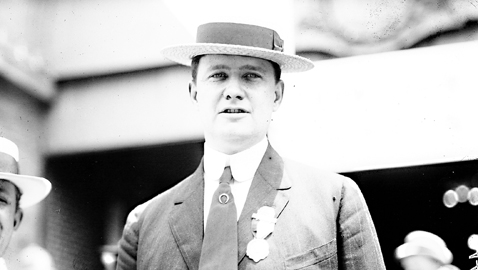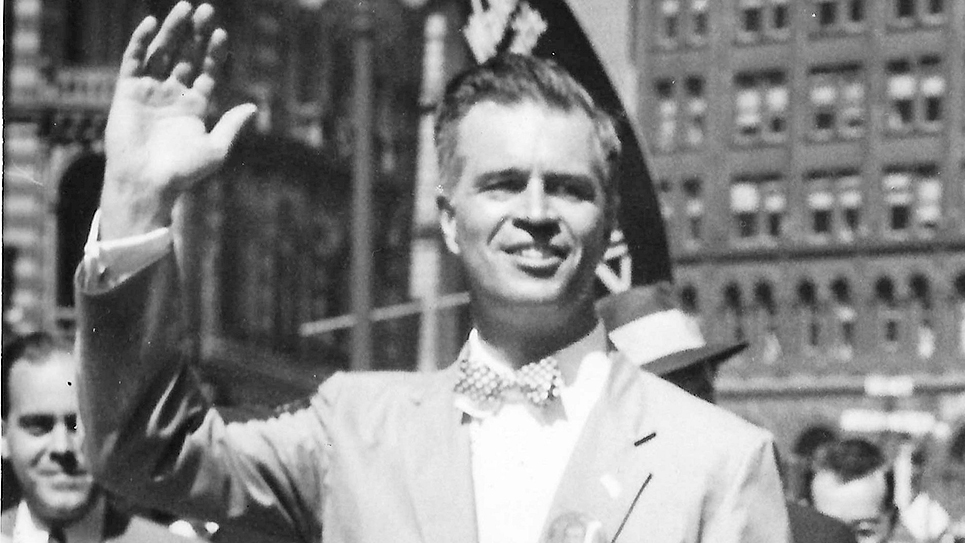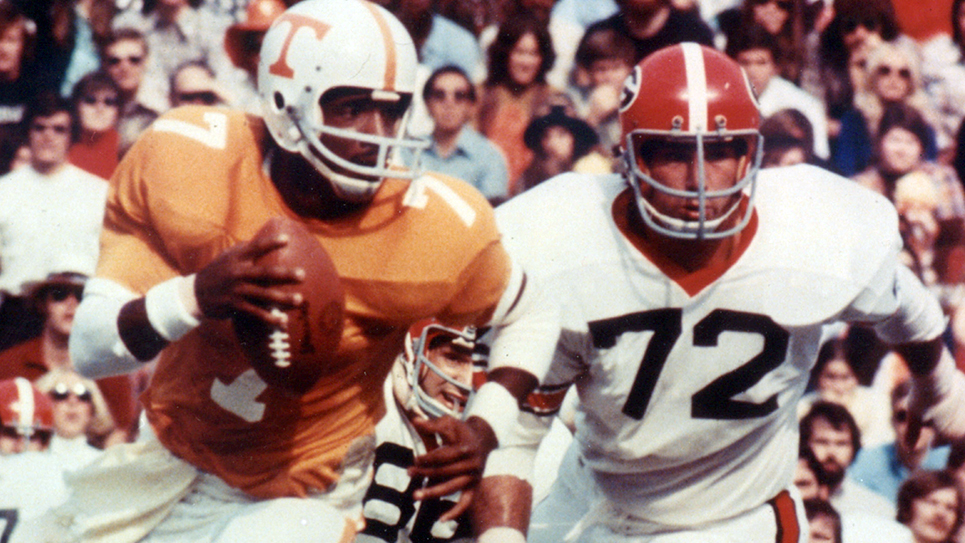2015 marks the one-hundredth year since the people of Tennessee cast their ballots to select a candidate for the United States Senate. There had previously been non-binding preferential primaries, as senators were still elected by the state legislature.
The 1915 primary was unusual in two respects; first it was no ordinary election year and the primary was held almost a year in advance of the 1916 general election. Secondly, it is the only primary election in modern Tennessee history, which featured two primaries. The first primary election would allow every contender to compete and the second was a run-off election between the two top vote getters.
The incumbent senator was Luke Lea, who had first been elected in 1911. Lea had been the youngest man ever to be elected to the United States Senate up to that time, just barely over the constitutional age of thirty. The legislature had been deadlocked in trying to select a senator that year. Senator James B. Frazier, a former governor of Tennessee, had very much wanted to be reelected, but it soon became readily apparent he could not muster the necessary votes to win. Finally, Luke Lea was elected through a fusionist movement; a combination of Democrats and prohibition Republicans provided the necessary majority. That same combination had helped to elect Republican Ben W. Hooper governor in 1910. The fusionist combine would continue to dominate Tennessee politics for a few more years. Hooper would be reelected governor in 1912 and John Knight Shields, a Democrat, would be elected U. S. senator in 1913. Shields was the last person in Tennessee ever to be elected to the United States Senate by the General Assembly.
By 1915, the fusionist tide had ebbed. Governor Ben W. Hooper had been defeated for a third two-year term in 1914 by Tom C. Rye, who had managed to unite the formerly sharply fragmented Democratic Party.
Luke Lea wished to be reelected and was a certain candidate to succeed himself, but the senator was himself a polarizing figure. Many Democrats blamed Lea for the strength of the fusionists and the party strife. Lea felt more secure in running for the Senate as he had strongly backed Tom C. Rye for governor and for much of the campaign he waited in vain for an endorsement from Rye that never came. Senator Lea had a propensity for injecting himself in party affairs and had made far more enemies than friends during his term of office. Not the least of which was Senator John Knight Shields. The two senators from Tennessee did not like one another at all.
Nor was Senator Lea a particularly well-liked figure with much of Tennessee congressional delegation, several of whom were contemplating running against him. Congressmen Cordell Hull, Thetus W. Sims, and Kenneth D. McKellar were all pondering Senate bids. Another formidable political figure, former governor Malcolm Rice Patterson, thought the time might be ripe for him to make a comeback. “Ham” Patterson had been governor from 1907-11 and had been seeking a third term when events of his own making drove him out of the race.
Malcolm Patterson was a very strong-minded person, deeply conservative, yet quite personally liberal by the standards of the time. Much of Tennessee’s Democratic Party had been deeply divided by the issue of prohibition. Governor Patterson had been openly “wet”, favoring local option. The governor also drank his convictions and made no secret about his fondness for having a drink. Patterson had been challenged by the champion of the dry forces in the 1908 gubernatorial primary, former U. S. senator Edward Ward Carmack.
The redheaded and volatile Carmack had lost his seat in the United States Senate in 1906 to perhaps the most popular politician in Tennessee, former governor Robert Love Taylor. Carmack only narrowly lost a non-binding preferential primary and the Tennessee General Assembly abided by the wishes of the voters. Carmack sought to return to the political stage by running against Patterson.
The ill feeling between Patterson and Carmack went far deeper than mere political opponents. E. W. Carmack had first come to Congress by unseating Patterson’s father, Colonel Josiah Patterson. The animosity between the two was palpable.
The gubernatorial campaign was especially bitter, but Patterson won. Carmack returned to his profession, being hired to edit the Nashville Tennessean, which was owned by none other than Luke Lea. Carmack’s editorials literally led to his death. The editor was shot down on the streets of Nashville when he encountered Colonel Duncan B. Cooper and his son, Robin. Carmack had been enjoying himself by torturing Governor Patterson and his friends in print, one of whom was Colonel Cooper. Upon seeing the Coopers, Carmack drew a gun and fired, slightly wounding Robin Cooper. The younger Cooper proved to be a far better shot than the editor and he hit Carmack at least three times, including one shot to the head and another to the heart. Carmack fell dead in the gutters of the street.
Duncan Cooper was a close friend and supporter of Malcolm Patterson and the governor would likely have survived and prospered politically were it not for his own arrogance and folly. Both Coopers were promptly indicted for murder and while Robin was released on a legal technicality. Colonel Cooper had been convicted. Just about everyone in Tennessee was stunned when Governor Patterson pardoned Duncan B. Cooper.
Outrage at the governor’s use of his pardoning power swept across Tennessee. Once again, the Democratic Party in the Volunteer State threatened to come apart at the seams. Patterson finally came to the realization he could not win a third term and would likely lose the general election and withdrew.
Patterson was further humiliated when he was caught drunk in a house of ill repute. The former governor claimed he had been framed by political enemies, but few believed him. Following the death of a son from drink, Malcolm Patterson claimed to have turned a new leaf and began lecturing on the evils of alcohol. Patterson clearly hoped the votes would forgive him of his previous lapses of judgment.
Congressman Cordell Hull finally decided he would not seek Luke Lea’s Senate seat; however, Hull was the architect of a plan for an early primary. Hull believed by having an early primary, well in advance of the general election, it would cripple Senator Lea’s ability to organize. Hull’s plan called for an initial primary in November of 1915, followed by a run-off election between the two top vote getters in December.
Congressman Thetus W. Sims, an eighteen year veteran of the U. S. House of Representatives, announced on July 27, 1915 he would run for Lea’s Senate seat. After a slow start, Sims thought better of it and changed his mind. He would run for reelection to his seat in Congress after all.
The senatorial race came down to three candidates: Senator Luke Lea, former governor Malcolm Patterson, and Congressman Kenneth D. McKellar. Lea was encouraged by the fact both Patterson and McKellar were from Memphis and he felt sure the two would divide the vote of the state’s most populous county between them. At the beginning of his campaign, Luke Lea believed he might get the support of E. H. Crump, leader of the Shelby County political organization. The Crump machine had yet to be perfected by the Boss and Crump was embroiled in being removed from office. Crump was distracted and played little part in the senatorial campaign, although he disappointed Senator Lea bitterly when he announced he was supporting Congressman McKellar.
Malcolm Patterson formally announced his own candidacy in Memphis on September 1, 1915, little more than two months before the primary election. The former governor was an excellent speaker, being described by one newspaper as a “versatile and brilliant orator”. Patterson launched his campaign, relying heavily on the prohibition issue. Once the acknowledged leader of the “wet” forces in Tennessee, Patterson sought to become the champion of the drys. It was an odd stance to take, as Senator Luke Lea had always been a prohibitionist.
Kenneth McKellar’s chief handicap as a candidate was also his saving grace. Virtually unknown throughout the state when the campaign began, McKellar methodically made his way through countless towns, cities, and counties, personally meeting as many people as he could.
Congressman McKellar said little about prohibition, although he was quick to tell anyone who asked, he did not personally drink alcohol. McKellar pitched his campaign on the theme of harmony. McKellar warned Democrats that both Lea and Patterson were highly divisive figures and the Republicans could very well win the general election should either be nominated. McKellar’s argument was bolstered when it became clear former governor Ben W. Hooper would be the GOP nominee. Few Democrats needed reminding that Hooper was likely the strongest candidate the Republicans could field.
Neither Lea nor Patterson seemed to consider Congressman McKellar much of a threat and the two concentrated their political fire upon one another. Lea regularly denounced Patterson from the stump, while the former governor routinely blistered the senator at every opportunity. McKellar, meanwhile, pounded home his theme of harmony and that he was the only candidate running around whom the Democratic Party could unite behind for the general election.
The Tennessee Senate race generated some national press and the Concord, North Carolina Daily Tribune described the contest as “one of the most spectacular campaigns” in Volunteer State history. Each of the candidates toured Tennessee constantly during the two months up to the first primary.
Much of the press was especially hostile to Malcolm Patterson and voters were constantly reminded of the former governor’s colorful past. The North Carolina Wilmington Dispatch characterized Patterson as a “political ringster and upholder of debauchery.”
As Lea and Patterson battered one another relentlessly, Congressman McKellar received a boost from Senator John Knight Shields. McKellar got on very well with the crusty senator who quietly told his many patronage appointees in Tennessee to fall behind the Congressman’s candidacy and do all they could to elect him.
When the first primary drew to a close, Senator Lea returned home to Nashville to rest before the election returns came trickling in the next day. Congressman McKellar made a speech in Jackson on the eve of the election, before returning home to Memphis to vote and visit with friends and supporters. Former governor Malcolm Patterson spoke in Arlington and hurried home to Memphis.
Despite the fact the fight for the senatorial nomination had been one of the “hottest” in memory, the voter turnout was relatively light. The results of the primary election were surprising. Senator Luke Lea ran third.
To the surprise of just about everyone, Congressman K. D. McKellar ran first, carrying both East and West Tennessee. Malcolm Patterson ran especially well in Middle Tennessee, which was home to Senator Lea. The senator did not even carry his home city of Nashville, which was won by former governor Patterson. McKellar carried the other big cities in Tennessee: Knoxville, Chattanooga, Memphis and Jackson. In Shelby County, McKellar won 5.905 votes to Patterson’s 2,327. Luke Lea won a total of 124 votes in Shelby County. McKellar and Patterson had indeed divided the vote in Shelby County, but unfortunately for Senator Lea, he barely received any at all.
Patterson had run unexpectedly strongly in Tennessee’s smaller towns and rural communities of the state. Yet, his performance in East Tennessee was extraordinarily poor. Senator John Knight Shields was from East Tennessee and his influence on McKellar’s behalf allowed the Congressman to carry the region over Senator Lea.
Lea accepted his defeat with good grace, saying, “Political postmortems are never interesting.”
The senator claimed, “…there are no sores or wounds” and declared he would “cordially support” whomever his fellow Democrats might nominate on December 15. Overall, McKellar had only led Patterson by little more than a couple thousand votes statewide. The former governor entered the run-off election confident of victory. Patterson denounced old friends and former supporters, perhaps hoping to reassure doubtful voters about his change of heart. Congressman McKellar continued stressing he was the most electable Democrat and his theme of party harmony. The bitterness between Luke Lea and Malcolm Patterson was so deep and so personal; it was highly unlikely many of the senator’s supporters would back the former governor.
Malcolm Patterson’s hopes were dashed when he lost the second primary decisively. McKellar duplicated his win from the first primary, once again carrying both East and West Tennessee. Once again, the former governor carried Middle Tennessee, but McKellar increased his majority, winning the Democratic primary by some 15,000 votes.
Patterson, like Lea before him, was gracious in defeat, conceding his loss early election night.
“I have been defeated and there are no explanations to make,” Patterson said.
The former governor went on to say he was not bitter towards those who had opposed him and pledged his support to K. D. McKellar as the Democratic nominee for the United States Senate.
As McKellar entered the general election in 1916, he already represented the future and while Ben W. Hooper, the Republican nominee, was relatively young, he remained a figure from the past. Kenneth D. McKellar would go on to become Tennessee’s first popularly elected United States senator. He would also be Tennessee’s longest serving senator, a record that remains unbroken to this day.







